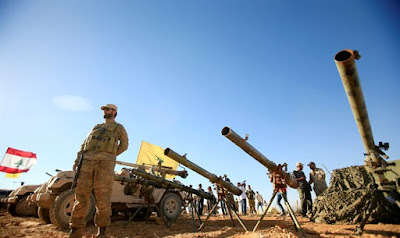By Hillel Fendel
Hezbollah fails in promised revenge bid; Netanyahu warns not to try again
The hostilities on Israel's border with Lebanon on Wednesday reinforced the IDF's deterrence power, but left the defeated Hezbollah hankering for another chance.
The story began last week when Israel reportedly killed a Hezbollah terrorist in the process of bombing weapons shipments that had arrived in Damascus from Iran. Hezbollah immediately announced that it would avenge the attack.
Hezbollah is a Lebanese terrorist organization led by Sheikh Hassan Nasrallah, who has been hiding in a bunker for no fewer than 14 years (!) for fear that Israel will target him. It often seeks to prove its strength to its Iranian patrons, so as to continue to receive its financial, military and political support.
The revenge attack that Hezbollah sought to carry out had one essential condition: It could not be such that would bring about a strong Israeli response deep inside Lebanon. It had to take place, therefore, in what could be considered non-Israeli territory, and could certainly not harm Israeli citizens. This left one option: an attack on an IDF tank or outpost in the Har Dov area of Mt. Hermon, which Hezbollah considers Lebanese territory.
Hezbollah's guided anti-tank missiles, generally of the Russian-made Kornet model, are no slacker; they can be controlled by the launcher even while still in the air – as long as he can see, using special binoculars, both the rocket and its intended target. Hezbollah is lacking high-quality night vision equipment, and can therefore carry out this type of operation only in daytime – and from a place where the target over a kilometer away can be clearly seen.
Analysts assume that 3-5 Hezbollah terrorists made their way through the overgrowth and large boulders that envelope the slopes of Har Dov, until they could find the perfect camouflaged spot from which to fire. But – the IDF has long been ready for such an attack, and especially over the past few days following Hezbollah's warnings of revenge. IDF tanks were readied in place, with turrets barely visible, and smoke cover was provided for potential Israeli targets. The IDF lookouts – generally female soldiers constantly monitoring the camera screens – were also well-prepared, and in fact had no difficulty identifying the terrorist cell even before it crossed the UN-set border. Though the terrorists' intentions were clear, the IDF held its fire until they crossed a few meters into Israeli territory – and then let loose.
At this point, things become unclear. Did the IDF kill them? Some of them? Were there wounded? Or did the army choose, in order not to escalate the situation, to merely scare them and allow them to flee safely back home? In any event, the Hezbollah attack was thwarted. Israeli residents in the area were soon given IDF permission to leave their homes and travel freely.
What's next? Hezbollah will likely lick its wounds and bide its time – though not for long – as it continues to seek ways to hit back at Israel. The coming days will be tense in northern Israel.
Prime Minister Netanyahu and Defense Minister Ganz issued a joint statement after the incident, warning Hezbollah not to "play with fire" and that Israel will not hesitate to respond with great force to any Hezbollah aggression.
Meanwhile, in Iran yet another mysterious explosion rocked the country on Tuesday, this time in the western province of Kermanshah, where six fuel tanks inexplicably blew up. This follows a long series of unexplained explosions in sensitive sites throughout the country, such as an ammunition dump on Qeshm Island in southern Iran, the Tondgooyan petrochemical plant, the Shahid Medhaj Zargan power plant, a gas storage tank complex near Mashad, and most notably, the Natanz nuclear facility — all in the month of July. It is assumed that an entity with an interest in preventing Iran from carrying out its nuclear and other hostile programs is behind the explosions. Who could that be, the world wonders?
